Kibo (ISS module)
The Japanese Experiment Module (JEM), nicknamed Kibō (きぼう, Kibō, Hope), is a Japanese science module for the International Space Station (ISS) developed by JAXA. It is the largest single ISS module, and is attached to the Harmony module. The first two pieces of the module were launched on Space Shuttle missions STS-123 and STS-124. The third and final components were launched on STS-127.[1]

Components
Kibō consists of six major elements:
- pressurized module (PM)
- exposed facility (EF)
- experiment logistics module–pressurized section (ELM-PS)
- experiment logistics module–exposed section (ELM-ES)
- Japanese Experiment Module remote manipulator system (JEMRMS)
- NanoRacks CubeSat Deployer
- Inter-orbit communication system (ICS).[2]
Pressurized module
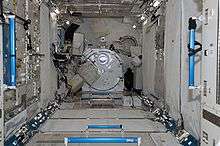
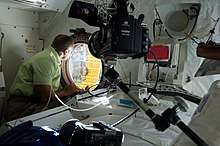
The PM (pressurized module) is the core component connected to the port hatch of Harmony. It is cylindrical in shape and contains twenty-three International Standard Payload Racks (ISPRs), ten of which are dedicated to science experiments while the remaining 13 are dedicated to Kibō's systems and storage.[3] The racks are placed 6-6-6-5 along the four walls of the module. The end of the JEM-PM has an airlock and two window hatches. The exposed facility, experiment logistics module, and the remote manipulator system all connect to the pressurized module. Kibō is also the location for many of the press conferences that take place on board the station.
Exposed facility
.jpg)
The exposed facility (EF), also known as "Terrace", is located outside the port cone of the PM (which is equipped with an airlock). The EF has 12 EFU (exposed facility unit) ports that attach to PIU (payload interface unit) connectors on EF-EEUs (EF-equipment exchange units). All experiment payloads are fully exposed to the space environment. For proper functioning of these experiments, the payload requires an ORU (orbital replacement unit) which consists of the EPS (electrical power system), CT (communications & tracking) and the TCS (thermal control system). Of the 12 ORUs, eight are replaceable by the JEMRMS while the other four are EVA-replaceable.
Experiment logistics module
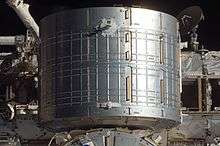
The experiment logistics module (ELM) includes two sections:
- The pressurized section (ELM-PS) – also called the JLP (Japanese logistics pressurized) – is a pressurized addition to the PM. The module is a storage facility that provides storage space for experiment payloads, samples and spare items.[4]
- The unpressurized (external) section (ELM-ES) serves the EF as a storage and transportation module.
Remote manipulator system
The remote manipulator system (JEMRMS) is a 10 meters (33 ft) long robotic arm, mounted at the port cone of the PM, intended to service the EF and to move equipment from and to the ELM. The RMS control console was launched while inside the ELM-PS. The main arm was launched with the PM. The small fine arm is 2 meters (6 ft 7 in) long and attaches to the end effector of the main arm, was launched aboard HTV-1 on the maiden flight of the HTV spacecraft. Once HTV docked the small fine arm was assembled by the crew and deployed out the airlock to test it. Once deployed outside the JEMRMS grappled it and unfolded the arm to flex the joints before stowing it onto the exposed facility.[5] The free end of the JEMRMS is able to use the type of grapple fixtures that the Canadarm2 uses.[6]
Launch sequence

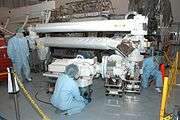
NASA launched the JEM complex over three flights using the Space Shuttle. The shuttle had a large payload bay which carried the modules into orbit along with the crew. This is in contrast to the Russian modules, which are launched into orbit on multistage Proton rockets and then rendezvous and dock with the station automatically. On 12 March 2007, the Experiment Logistics Module Pressurized Section (ELM-PS), the main laboratory, arrived at the Kennedy Space Center (KSC) from Japan.[7] It was stored in the Space Station Processing Facility until launched into orbit aboard Space Shuttle Endeavour as part of the STS-123 mission.[8]
On 30 May 2003, the Pressurized Module (PM) arrived at KSC from Japan.[9] It was stored at the Space Station Processing Facility until launched into orbit aboard Space Shuttle Discovery as part of the STS-124 mission.[10] On 3 June 2008, the PM was attached to the Harmony module. At first the ELM-PS, the small cargo bay, was connected to a temporary location on Harmony and later, on 6 June 2008, was moved to its final berthing location on top (zenith) of the main laboratory.
The EF and ELM-ES arrived at KSC on 24 September 2008.[11] The Exposed Facility (EF) and ELM-ES were launched on STS-127, on 15 July 2009.[12] The ELM-ES was brought back to Earth at the end of the mission. The assembly of the EF was completed during the fifth spacewalk of the mission.[13]
Specifications

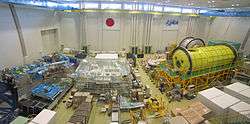

Kibō is the largest single ISS module:
- Pressurized module[14]
- Length: 11.19 meters (36.7 ft)
- Diameter: 4.39 meters (14.4 ft)
- Mass: 15,900 kilograms (35,100 lb)
- Experiment logistics module - Pressurized Section[15]
- Length: 4.21 meters (13.8 ft)
- Diameter: 4.39 meters (14.4 ft)
- Mass: 8,386 kilograms (18,488 lb)
The module and all its integrated accessories were manufactured at the Tsukuba Space Center in Japan. It is made from stainless steel, titanium, and aluminum.
Current external experiments on Kibō
- MAXI - X-ray astronomy from 0.5 to 30 keV.[16] Exposed Facility Slot 1.
- CREAM - Cosmic Ray Energetics and Mass. Launched on SpaceX CRS-12. Exposed Facility Slot 2.
- OCO-3 - Monitoring of carbon dioxide in the Earth's atmosphere using a flight spare from OCO-2.[17] Exposed Facility Slot 3 port originally held SMILES.
- NREP - Nanoracks External Platform. NREP-2 is the current mission on this pallet. Exposed Facility Slot 4.
- i-SEEP - IVA-replaceable Small Exposed Experiment Platform (JAXA). Mounted to Exposed Facility Slot 5.[18] It is a platform to support small-to-medium (less than 200 kg) payloads. Experiments on the i-SEEP platform are HDTV-EF2 (since 2017), GPSR/Wheel,[19] and SOLISS (since 2019).[20]
- GEDI - Global Ecosystem Dynamics Investigation on ISS Exposed Facility Slot 6 port originally held HREP.
- HISUI - Hyperspectral Imager Suite (METI) replacement for HREP which ended its mission in 2017.[21] Exposed Facility Slot 8 port originally held MCE.
- CALET - CALorimetric Electron Telescope (JAXA), observation for high energy. Launched aboard HTV-5.[22] Mass: 2500 kg.[23] Exposed Facility Slot 9 port originally held SEDA-AP.
- ExHAM 1 and 2 - External Facility Handrail Attach Mechanism (JAXA).[24] Mounted to the deck on handrails in the forward and aft locations next to slots 7 and 10.
- ECOSTRESS - Ecosystem Spaceborne Thermal Radiometer Experiment on Space Station.[25] Exposed Facility Slot 10 port originally held the ELM-ES and the HTV Transfer Pallet.
Former external experiments on Kibō
Deorbited with HTV-5:
- SMILES - Observes and monitors very weak sub-millimeter wave emission lines of trace gas molecules in the stratosphere.[26]
- MCE - Multi-mission Consolidated Equipment (NASA).
Deorbited with SpaceX CRS-15:
- HREP (Hyperspectral Imager for the Coastal Ocean (HICO) and Remote Atmospheric and Ionospheric Detection System (RAIDS) Experimental Payload).[27]
Deorbited with SpaceX CRS-17:
- CATS - Cloud-Aerosol Transport System (LiDAR, NASA),[28] originally held in Slot 5 will be replaced by MOLI.
Jettisoned into orbit by ISS robotic arm:[29][30]
- SEDA-AP (Space Environment Data Acquisition equipment-Attached Payload) - Measures neutrons, plasma, heavy ions, and high-energy light particles in the station's orbit.
- ICS-EF - Inter-orbit Communication System - Exposed Facility, Japanese communication system. Originally at the Exposed Facility Slot 7.
Planned external experiments on Kibō

- MOLI - Multi-footprint Observation Lidar and Imager (JAXA)
Current internal experiments on Kibō
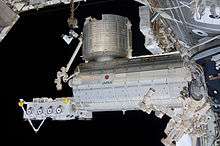
Japanese:
- RYUTAI Rack - Fluid Physics Experiment Facility (FPEF), Solution Crystallization Observation Facility (SCOF), Protein Crystallization Research Facility (PCRF), Image Processing Unit (IPU)
- SAIBO Rack - Cell Biology Experiment Facility (CBEF), Clean Bench (CB)
- KOBAIRO Rack - Gradient Heating Furnace (GHF)
- MPSR-1 - Multi-Purpose Small payload Rack
- MPSR-2 - Multi-Purpose Small payload Rack, housing Electrostatic Levitating Furnace (ELF)
American:
- EXPRESS Rack 4 - Biotechnology Specimen Temperature Controller (BSTC), Gas Supply Module (GSM), Space Acceleration Measurement System-II (SAMS-II), Biotechnology Specimen Temperature Controller (BSTC), Nanoracks NanoLab
- EXPRESS Rack 5
- MELFI-1 two -80° freezer racks.
- Life Sciences Glovebox (LSG)
Planned internal experiments on Kibō
Parts
 Pressurized Module
Pressurized Module.jpg) Experiment Logistics Module-Pressurized Section
Experiment Logistics Module-Pressurized Section Exposed Facility
Exposed Facility.jpg) Experiment Logistics Module-Exposed Section
Experiment Logistics Module-Exposed Section Remote Manipulator System
Remote Manipulator System
See also
- Scientific research on the ISS
References
- Kamiya, Setsuko (30 June 2009). "Japan a low-key player in space race". Japan Times. p. 3. Archived from the original on 3 August 2009.
- "About Kibo". JAXA. 25 September 2008. Archived from the original on 10 March 2009. Retrieved 6 March 2009.
- "Kibo Japanese Experiment Module". NASA. Archived from the original on 23 October 2008.
- "STS-123 MCC Status Report #11". NASA. 16 March 2008. Archived from the original on 18 March 2010.
- "Remote Manipulator System". JAXA. Archived from the original on 20 March 2008.
- "HTV-1 Mission Press Kit" (PDF). JAXA. 2 September 2009. p. 19. Archived (PDF) from the original on 2 April 2015. Retrieved 31 January 2015.
- "Shipping of the Kibō ELM-PS, Kibō RMS and Kibō experiment racks". JAXA. Archived from the original on 5 May 2008.
- "NASA's Shuttle Endeavour Begins Mission to the Space Station". NASA. Archived from the original on 18 March 2008.
- "Kibo PM arrival in USA". JAXA. Archived from the original on 19 September 2007.
- "NASA's Shuttle Discovery Launches With Japanese Laboratory". NASA. Archived from the original on 12 October 2008.
- "Kennedy Media Gallery;— Photo No: KSC-08PD-2924". NASA. Archived from the original on 8 June 2011.
- "STS-127 mission page". NASA. Archived from the original on 16 July 2009.
- Harwood, William (27 July 2009). "Endeavour crew completes fifth and final spacewalk". NASASpaceFlight.com. Archived from the original on 31 July 2009. Retrieved 29 July 2009.
- "STS-124 Press Kit" (PDF). NASA. Archived (PDF) from the original on 24 November 2010.
- "STS-123 Press Kit" (PDF). NASA. Archived (PDF) from the original on 24 June 2008.
- "Monitor of All-sky X-ray Image: MAXI". JAXA. Archived from the original on 21 May 2013.
- "OCO-3". NASA Science Mission Directorate. Archived from the original on 3 May 2018. Retrieved 7 May 2018.
- "IVA-replaceable Small Exposed Experiment Platform (i-SEEP)/Payload Interface Control Document" (PDF). JAXA. July 2017. Retrieved 25 February 2020.
- "IVA-replaceable Small Exposed Experiment Platform (i-SEEP)". JAXA. 31 October 2016. Retrieved 25 February 2020.
- 宇宙探査イノベーションハブとリコー、 THETAをベースに共同開発したカメラで360°全天球静止画・動画を撮影・公開. JAXA. 17 October 2019. Retrieved 25 February 2020.
- Japan Space Systems. "HISUI : Hyper-spectral Imager SUIte | Project | Japan Space Systems". ssl.jspacesystems.or.jp. Retrieved 23 December 2019.
- "About the cooperation of JAXA and ASI in the development of CALET". JAXA. 10 June 2013. Archived from the original on 10 January 2014. Retrieved 10 January 2014.
- Torii, Shoji (24 February 2006). "The CALET Project for Investigating High Energy Universe" (PDF). Waseda University, Advanced Research Institute for Science and Engineering; University of Tokyo, Institute for Cosmic Ray Research. Archived from the original (PDF) on 16 June 2007.
- "ExHAM : Experiment - International Space Station - JAXA". iss.jaxa.jp. Retrieved 6 March 2020.
- Keeter, Bill (5 July 2018). "ISS Daily Summary Report – 7/05/2018". NASA.
- "Superconducting Submillimeter-wave Limb-emission Sounder: SMILES". JAXA. Archived from the original on 28 September 2006.
- Keeter, Bill (11 July 2018). "ISS Daily Summary Report – 7/11/2018". NASA.
- "Robotics and Space Biology Today as Cosmonauts Look to Next Spacewalk – Space Station". blogs.nasa.gov. Retrieved 14 May 2019.
- きぼう船外設置の宇宙環境計測ミッション装置(SEDA-AP)をISSから廃棄しました (in Japanese). JAXA. 21 December 2018. Retrieved 21 December 2018.
- 衛星間通信システム船外部(ICS-EF)をISSから廃棄しました (in Japanese). JAXA. 25 February 2020. Retrieved 25 February 2020.
External links
| Wikimedia Commons has media related to Japanese Experiment Module. |
- Japanese Experiment Module (Kibō) at JAXA.jp
